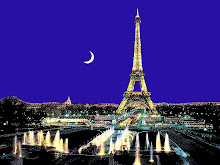

The
Bir-Hakeim Bridge crosses the Seine River, just south of the Eiffel Tower. Tourists may often not have the time to go so far, but it’s actually one of the best places to watch the Tower and it’s also a beautiful piece of art by itself.
The bridge was built (actually rebuilt) in 1905 in two levels, allowing the passage of the then new metro, plus cars, pedestrians, bikers… It was originally called the Passy Bridge, named after the area Passy on the right bank. It got its new name in 1948 to commemorate the battle of Bir Hakeim (Libya 1942-43).
The two Scottish guys you can see on one of the pictures are probably here for the soccer game France – Scotland, played last night (0-1) or maybe on their way to the rugby match in Toulouse, where France also meets Scotland (World Championships) next weekend.

The bridge crosses the Ile des Cygnes (the Swan Island). You can use some stairs and then take a walk all along the narrow island to its extreme south, where you can find the smaller version of the Statue of Liberty.

The statue you see is a gift from the Danish colony in France (1930) and the decorations on the side of the bridge date from its creation; symbols of the French nation are fixed to the bridge.

 The bridge has "co-starred" in several films, the most famous one perhaps being the Last Tango in Paris by Bertolucci with Marlon Brando; the apartment was situated in the last corner building, just at the starting point of the bridge.
The bridge has "co-starred" in several films, the most famous one perhaps being the Last Tango in Paris by Bertolucci with Marlon Brando; the apartment was situated in the last corner building, just at the starting point of the bridge.
Some of the original photos can be seen on my other blog , "Peter-photos".
 In the meantime my blog will sleep, but you are of course welcome to comment, including on the interview made by Cuckoo (see below)… or ask her to interview you. That could give me something extra and interesting to read when I’m back!
In the meantime my blog will sleep, but you are of course welcome to comment, including on the interview made by Cuckoo (see below)… or ask her to interview you. That could give me something extra and interesting to read when I’m back!
 Graffiti can be nice if well done on appropriate places, but I think this is really a pity. Some young painters have obviously been hired by the shop owners to make the original work – and quite nicely - and then some others have not seen the “value” of this. … and why were two left? By a specific respect for Modigliani and Vermeer? I doubt.
Graffiti can be nice if well done on appropriate places, but I think this is really a pity. Some young painters have obviously been hired by the shop owners to make the original work – and quite nicely - and then some others have not seen the “value” of this. … and why were two left? By a specific respect for Modigliani and Vermeer? I doubt.

 This reminded me of some other remarkable ceramic buildings. Here you can see two buildings created 1900-01 (Avenu Rapp, 7th arrdt.), in a rather extreme “art nouveau” style by Jules Lavirotte (1864-1928). The façade, especially on one of them, has a very rich decoration, a mixture of vegetal and more or less erotic symbols (the entrance door - top picture - was almost “censored”).
This reminded me of some other remarkable ceramic buildings. Here you can see two buildings created 1900-01 (Avenu Rapp, 7th arrdt.), in a rather extreme “art nouveau” style by Jules Lavirotte (1864-1928). The façade, especially on one of them, has a very rich decoration, a mixture of vegetal and more or less erotic symbols (the entrance door - top picture - was almost “censored”). 
 The last building I wanted to show today was built in 1903 (rue Franklin, 16th arrdt.) and the architect here is Auguste Perret (1874-1954). Perret later worked in a style, much closer to Le Corbusier. One of his major achievements was the reconstruction of Le Havre after the Second World War, much criticised in the beginning, but today in much higher esteem.
The last building I wanted to show today was built in 1903 (rue Franklin, 16th arrdt.) and the architect here is Auguste Perret (1874-1954). Perret later worked in a style, much closer to Le Corbusier. One of his major achievements was the reconstruction of Le Havre after the Second World War, much criticised in the beginning, but today in much higher esteem. 











 Most of these pictures can be found on my other blog,
Most of these pictures can be found on my other blog, 

 There are also separate meeting rooms and a number of corners where the deputies can work, have their more informal discussions, have a drink...
There are also separate meeting rooms and a number of corners where the deputies can work, have their more informal discussions, have a drink...



 Today I will just show you what it all looks like from the outside, the gardens… and also a first look at the inside; some of the chandeliers. I suppose they must have a favourable tariff for electricity! Tomorrow I will show you something of the more official “working space” and then at last some of the magnificent reception rooms.
Today I will just show you what it all looks like from the outside, the gardens… and also a first look at the inside; some of the chandeliers. I suppose they must have a favourable tariff for electricity! Tomorrow I will show you something of the more official “working space” and then at last some of the magnificent reception rooms. 




 When I have finished with the Assembly, I will put some originals on my other blog, “Peter – photos”.
When I have finished with the Assembly, I will put some originals on my other blog, “Peter – photos”. 




 As a “proof”, I found this old picture of “my” pharmacy as it looked in the beginning of the 20th century, to be compared with my photo.
As a “proof”, I found this old picture of “my” pharmacy as it looked in the beginning of the 20th century, to be compared with my photo.  During the same walk I took also a few pictures of some statue like decorations on the front of buildings, probably from the middle of the 19th century. There was more attention paid to the decorative part then than on today’s buildings.
During the same walk I took also a few pictures of some statue like decorations on the front of buildings, probably from the middle of the 19th century. There was more attention paid to the decorative part then than on today’s buildings. 
 Related to decoration: Would you like to redecorate your bathroom? These pictures are from a specialised shop, also “around the corner” (pictures taken through the windows).
Related to decoration: Would you like to redecorate your bathroom? These pictures are from a specialised shop, also “around the corner” (pictures taken through the windows). 


















